State of the Province: Sketching the state of the provinces
State of the Province: Sketching the state of the provinces sadminGovernment priorities
President Jacob Zuma's State of the Nation Address (SoNA) highlighted infrastructure development, which will enhance economic growth and job creation in the nine provinces.
A glance at the SoNA and the spending pattern among the nine provinces, clearly indicates that provincial growth and development strategies are aligned with the President’s vision, particularly in the priority areas of job creation, education, rural development and health.
Vuk’uzenzele unpacks some of the highlights of the provinces’ State of the Province Addresses and their alignment with the SoNA.
North West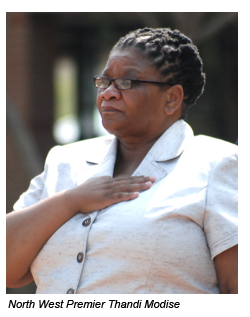
Premier Thandi Modise highlighted education and recreation as priorities, saying the North West government would be building libraries and recreational centres at Lomanyaneng, Mahikeng, 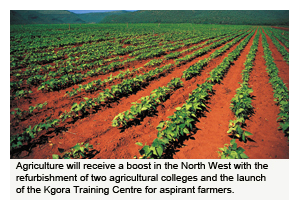 Manthe, Moretele, Lichtenburg and Schweizer-Reneke.
Manthe, Moretele, Lichtenburg and Schweizer-Reneke.
She said the Taung and Potchefstroom agricultural colleges were being refurbished and the provincial government would be launching the Kgora Training Centre to afford emerging and aspirant farmers practical farming experience.
Regarding the planning of roads, the provincial government has approached the South African National Roads Agency for assistance with improving the roads infrastructure.
Electricity infrastructure received a boost with an Eskom investment of R10,85 billion over the next five years. During the current financial year, a total of 10 162 new electricity connections will be made.
Premier Modise noted that the province had exceeded its own job-creation target of 52 898 jobs by creating 80 433 jobs.
In addition, the rehabilitation of the Vaalharts water scheme would create jobs and boost economic growth. This would not only benefit the North West province, but also the Northern Cape, she added.
Limpopo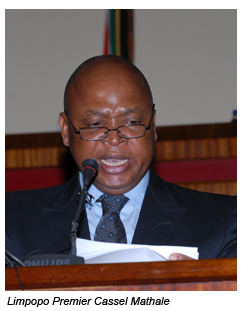
Premier Cassel Mathale said infrastructure expansion had been identified as one of the key pillars for improving living conditions in Limpopo, while also creating jobs.
The provincial government aimed to create 124 626 jobs by the end of the third quarter of the current financial year, he said Infrastructure development programmes include schools and the revitalisation of hospitals and clinics. Mathale noted that 32 schools and 2 431 classrooms had been built. Seven new clinics had also been built and 32 upgraded and the Siloam Hospital would be revitalised.
He said the province had signed a memorandum of understanding with Transnet Freight Rail to create logistics hubs to bring together transport infrastructure for agriculture, mining products and other commodities that had to be railed to other parts of the country and abroad. Logistics hubs, which will reduce the number of heavy goods on the roads, will be created in Polokwane, Musina, Burgersfort and Lephalale.
The Lephalale corridor and the plan to develop and integrate rail, road and water infrastructure, centred on Lephalale and Steelpoort will attract more investment. In the north, the Musina to Africa Strategic Supplier Hub Initiative (MUTASSHI) will promote north to south trade relations.
Gauteng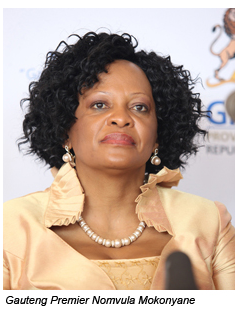
Premier Nomvula Mokonyane said the Gauteng provincial government was committed to accelerating the implementation of mega projects to drive growth and development. The projects formed an essential part of the Integrated Infrastructure Development Programme to promote job creation.
More than R500 million would be spent on the construction and maintenance of roads. This would include major rehabilitation of the N14 and the R25, Mokonyane said.
"We will also upgrade the R82 (the old Vereeniging Road) linking Johannesburg and Sedibeng, as well as William Nicol Drive. The construction of the K154 will be undertaken, stimulating development in the rural parts of south Sedibeng."
As part of rural development, roads in five rural development nodes would be upgraded, Mokonyane noted. "Through the S'hambaSonke road maintenance project, we will capacitate 100 new contractors and create 6 500 jobs."
On the information, communication and technology front, Premier Mokonyane said the province had embarked on efforts to build the knowledge economy as a driver of development. This will be done through the G-link Project, which aims to achieve 95 per cent broadband coverage in the province, roll out e-government services and grow the economy.
The provincial government is also planning a climate innovation centre and a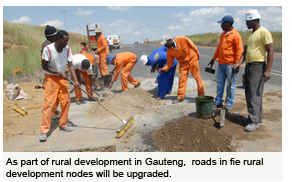 bio-science park at the Innovation Hub in Pretoria to help entrepreneurs
bio-science park at the Innovation Hub in Pretoria to help entrepreneurs
to develop green technologies.
On job creation, Mokonyane said that by the end of December 2011, the provincial government had exceeded its job creation targets, creating 281 686
jobs against a target of 229 904 by the end of March 2012. Of these, 5 629 were permanent jobs, 40 898 were temporary and 235 159 were jobs created through the Expanded Public Works Programme.
Regarding human settlements, progress had been made with implementing of 14 mixed housing developments, while 69 informal settlements had been formalised.
Free State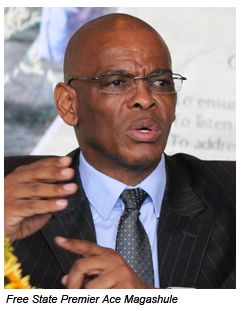
Free StatePremier Ace Magashule said a partnership between the Free State Development Corporation, the Mangaung Metro and the provincial Department of Human Settlements would facilitate the building of 3 000 housing units for people who earn above
R3 500, but who do not qualify for housing loans from banks.
A similar partnership was entered into with the Moqhaka Local Municipality to construct 2 000 mixed housing development units at Viljoenskroon and Kroonstad.
Various initiatives, including a dairy project in Vrede would see the creation of 33 954 job opportunities. In addition, the provincial government had drawn up a database of unemployed graduates for placement in internships, the Premier said.
Regarding infrastructure development, the Harrismith Logistics Hub, now part of the Durban-Free State-Gauteng corridor, will promote and stimulate economic growth in the Free State.
This includes a containerised manganese project in Bloemfontein in a partnership between the Free State Development Corporation and Transnet. It will link the mines of the Northern Cape, containerising the manganese cargo in Bloemfontein and transporting it by rail to Durban for export.
The provincial government has strengthened its relationship with Eskom to promote service delivery. Last year, Eskom completed 6 559 connections and is targeting an additional 1 454 this year. An additional six compact fluorescent light (CFL) roll-out projects and 11 energy efficiency projects were implemented at a cost of R128 million. This is in addition to the 2,1 million CFLs, 14 684 solar water geysers and 24 897 ripple control units that have been delivered since 2007.
Eastern Cape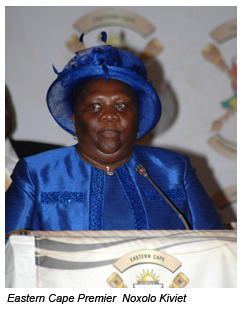
The Eastern Cape's East London industrial development zone (IDZ) has secured private investors to the value of R4 billion. Of this, R3,3 billion had been set aside for renewable energy projects, Premier Noxolo Kiviet said.
The Coega IDZ has 21 operating investors and has created 3 645 construction jobs, and 2 985 direct jobs. In addition, the Coega IDZ is implementing projects to the value of R7,6 billion. The R1 billion First Automobile Works automotive investment will create 2 000 direct jobs.
The Eastern Cape government supports co-operatives through the Imvaba Fund, with 46 cooperatives established and 16 new entrants supported so far.
Of the targeted 94 504 jobs announced for Phase 2 of the Expanded Public Works Programme (EPWP), 110 472 have been created. Similarly, 2 622 EPWP beneficiaries throughout the province were trained in technical and life skills. "Our target is to create 116 958 jobs in the current financial year", Premier Kiviet said.
The upgrading of the N2 Wild Coast, at a cost of approximately R9 billion, had been approved and construction would start soon. This project would create some 6 800 direct jobs and open up the Wild Coast for investment, the premier noted.
Regarding housing, 8 303 houses had been completed while a further 7 870 are being constructed. In addition, 2 397 units have been repaired.
Western Cape 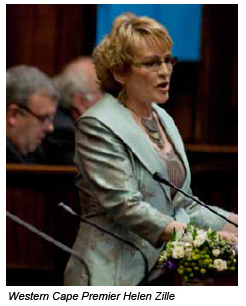
Premier Helen Zille said the provincial government had established an Economic Development Partnership (EDP) to develop a shared agenda for economic growth, development and inclusion. The EDP would focus on developing a shared economic vision, strategy and brand for the province.
In addition, the Western Cape has compiled an infrastructure agenda that includes regeneration projects in conjunction with the City of Cape Town and the private sector, the building and upgrading of roads including a divisional road between Gansbaai and Bredasdorp and the Wingfield interchange bridges and a roads network improvement project in support of the Saldanha Industrial Development Zone initiative.
The Premier announced a massive new investment in education infrastructure. "We have increased our schools maintenance budget by 46 per cent in the last two years," she said.
Plans for the next two years include building eight new schools and replacing 23 current school buildings. There are also plans to build 768 new classrooms and replace 583 current classrooms by the end of next year. By the end of the 2011/2012 financial year, 11 new schools and five replacement schools, as well as 570 classrooms will have been completed.
A public-private partnership has been established to bring broadband access to every school in the province.
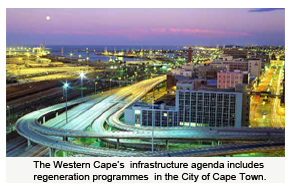
KwaZulu-Natal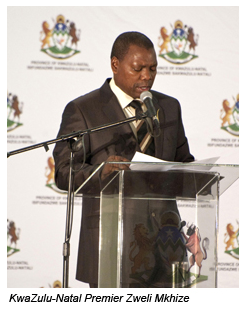
Premier Zweli Mkhize said the provincial planning commission had worked very hard to ensure that the Provincial Growth and Development Strategy and Plan were fully aligned with the National Development Plan.
Last year, the province obtained an allocation of R11 billion, which has since been raised to R15 billion for schools infrastructure, roads and water, as well as the upgrading of ports and the rail transport strategy.
The Department of Water Affairs has started a massive water supply programme to increase bulk water supply and establish more water treatment plants and storage facilities in the province. Around R18 billion has been allocated to raise the wall of the Hazelmere Dam, complete the construction of Spring Grove Dam in Mooi River, Umgungundlovu to augment the Umngeni River catchment.
Other major water projects include Ngagane water treatment works and transfer, Jozini-Ingwavuma bulk water supply, Mandlakazi water scheme, Msinga and Vant's Drift bulk and Mhlabashane Dam. Water supply and sanitation projects are also in the pipeline for Amajuba and Umkhanyakude districts.
Northern Cape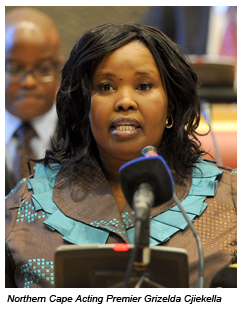
In a quest to improve the quality of teaching and learning, Northern CapeActing Premier Grizelda Cjiekella said the provincial government has, in collaboration with the Sishen Iron Ore Community Development Trust and Rhodes University, entered into a four-year capacity-building programme for teachers.
Some 108 teachers would study towards bachelor of education degrees in the foundation phase, mathematics and languages. The province would also soon have its own university as announced during President Jacob Zuma's State of the Nation Address, the Premier noted.
She said from the first to the second quarter of 2011, 3 000 jobs had been created in the Northern Cape. Various projects had also been identified to drive job creation. They included a rooibos tea processing and packaging project, revitalisation of Warrenton Superchicken and the Vaalharts irrigation scheme, upgrading of the Heuningvlei bulk water infrastructure, a hydroponics packing facility at Tshwaraganang hydroponics, the Blocuso irrigation development and the Riemvasmaak irrigation development.
For 2012/2013, R336 million has been set aside to develop human settlements, which will go a long way towards addressing the housing backlog. A total of 2 515 houses will be built through different projects.
Mpumalanga 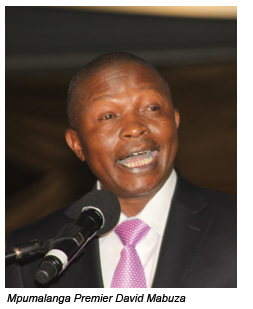
Premier David Mabuza said the provincial government concluded the crafting andadoption of the Mpumalanga Economic Growth and Development Path, which would guide the province in terms of job creation, economic growth and development.
From April 2009 to date, the province had created 135 793 jobs through the Expanded Public Works Programme. The province had also established more than 13 000 job opportunities through the Comprehensive Rural Development Programme the beneficiaries being predominantly youth and women, he noted.
As announced by President Jacob Zuma in his State of the Nation Address, the province will soon have its own university into which a tertiary training hospital will be incorporated.
As part of enhancing comprehensive support to poor learners, the no-fee school policy has been rolled out in 1 604 schools. In addition, 832 254 learners in primary and secondary schools are benefiting from the school nutrition programme.
The province will continue to enhance its Artisan Skills Training Programme benefiting at least 90 learners in line with the Comprehensive Rural Development Programme.
In partnership with the Department of Higher Education and Training, the province intends to create and strengthen system-wide partnerships with training institutions to help graduates obtain workplace training. The province will allocate 200 bursaries in scarce and critical skills.
The Mpumalanga Regional Training Trust has trained more than 600 young people in construction-related trades linked to the implementation of the Peoples Housing Programme. Almost 2 000 houses have been completed and further 2 547 are being built.
The Marapyane Agricultural College has been officially opened with 120 students enrolled and 20 lecturers already appointed.